Soups and Dragons
Ljubljana is one of the smallest capital cities in Europe with just over a quarter million residents. But unlike Dubrovnik in neighboring Croatia, which has been overrun with Game of Thrones tourists, Ljubljana remains relatively undiscovered. And that’s odd, because you’d think GOTers would love the dragon that is the symbol of the city and the iconic Dragon Bridge.
A Short History
The marshes around Ljubljana were inhabited 4,000 years ago, maybe earlier. Around the time of Christ, the Romans arrived, and then in the 6th century, the Slavs moved in. Around the 11th century, the castle was built.
An earthquake in the 16th century resulted in much of the city being rebuilt in the Renaissance style, including the castle, much of which dates from this period.
Another earthquake in 1895 flattened buildings and much of the city was rebuilt in the Vienna Secession style as the city was under the control of the Habsburg Empire.
Slovenia became part of Yugoslavia after WWII and was the first to secede when the country declared independence in 1991. A ten day war with the Yugoslav Army resulted in complete independence for Slovenia from the Yugoslav state. Forty-four members of the Yugoslav Army were killed, while eighteen on the Slovene side lost their lives. Twelve foreign nationals, mostly journalists, were also killed in the short-lived conflict. It’s interesting that Yugoslavia was so willing to let Slovenia have their independence while it fought a long and bloody war with Croatia who declared independence at the same time.
Foodie Ljubljana
Jota and Ričet
Because of the Italian influence in Slovenia, especially in the Slovene area of the Istrian Peninsula, pizza and pasta are easy to find in Ljubljana. But, you can also find traditional Slovenian food which is hearty and delicious.
Jota is a stew that is available all over the city. The recipe can vary, but mostly you’ll have some combination of beans, potatoes, sauerkraut, and lots of garlic with some kind of smoked pork. There are several vegetarian/vegan cafés in Ljubljana, so vegan jota is available.
Ričet is a similar dish, although it doesn’t contain sauerkraut and uses barley. I am a big fan of ”˜peasant food.” I don’t use that term as a pejorative, but as a compliment to express the method of making very flavorful dishes simply using fresh, local ingredients that are readily available. Ričet certainly fits the bill although it has the dubious distinction of being the soup often fed to prisoners.
štruklji
Almost every culture has some kind of dumpling as a snack or staple, and in Slovenia that dumpling is the štruklji. While štruklji used to be made only for holidays, today they are ubiquitous. In fact, don’t be surprised if you’re offered štruklji when visiting a Slovene in their home.
Made from wheat or buckwheat dough, the štruklji is traditionally filled with cottage cheese or fruit or nuts. But today, chefs are filling štruklji with all kinds of sweet and savory fillings. Everything from minced meat or carrots to chocolate hazelnut to dried fruit might be found inside your štruklji.
štruklji are often topped with a sauce, but you can still get them for take-out at fast food places in the city. Get a few different kinds and share them with a friend.
Moji štruklji is a great place to get a štruklji or two.
The Dragon Bridge
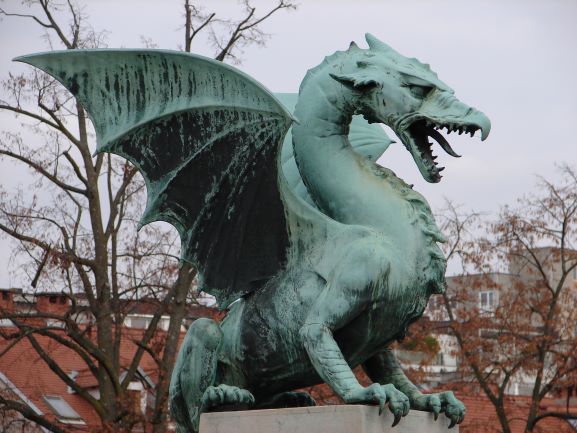
Legend has it that the capital of Slovenia was founded by Jason of Argonauts fame. He, of course, with the help of Medea, stole the Golden Fleece from a dragon by putting the beast to sleep.
Later, Jason’s adventures brought him up the Ljubljanic River where they came upon another dragon. Wanting to build a settlement, Jason had to kill the dragon. But, his sword couldn’t penetrate the beast’s leathery skin. So, again with the help of Medea, he put the dragon to sleep, bound his mouth with chains and filled the monster’s nostrils with the bones of his victims. When the dragon awoke, he flew into the sky in a rage of confusion, trying to spout flames from his mouth and nose, but only managing wisps of smoke. The fire inside the dragon, unable to escape, eventually engulfed him, causing the flying lizard to explode in the sky.
Today, just north of the open-air central market in Ljubljana is the famous Dragon Bridge (Zmajski most). There has been a bridge at this spot, crossing the Ljubljanica River, for at least 200 years.
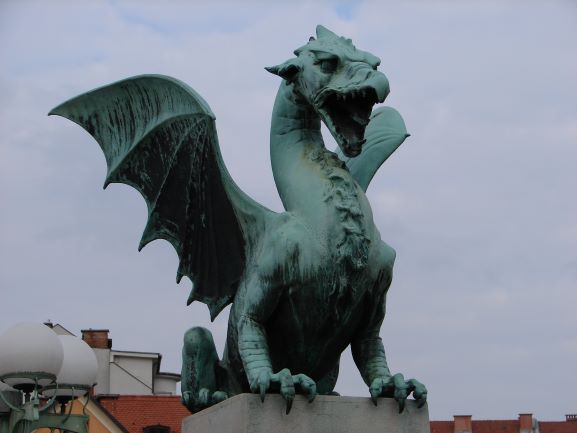
The Dragon Bridge itself was completed in 1901 and was originally named The Jubilee Bridge of Emperor Franz Josef I, after the Emperor of Austria. The Slovenes wisely renamed the bridge after Austria’s defeat in WWI.
The bridge itself was designed and built by Austrians and is one of the first reinforced concrete bridges in Europe. So, why was such an important step forward in engineering built by the Austrian empire in a relative backwater like Ljubljana? Because, if the structure failed, it would be less embarrassing to the Austrian monarchy than if it were built in Vienna. Of course, the bridge stayed up, and today the Dragon Bridge is deservedly celebrated as an icon of the city with its four imposing monsters guarding the passage.
While the legend of Jason slaying the dragon is fantastic, my favorite legend about the dragon is more modern. It says that whenever a virgin crosses the Dragon Bridge, the dragon wags his tail. I did field research for several hours at the Dragon Bridge and not once did I see a tail wag. So, there is only one conclusion that can be drawn”¦
Triple Bridge
Connecting the pedestrian-only medieval part of Ljubljana to the modern city is the Triple Bridge. Designed by architect Jože Plečnik. He added two non-parallel bridges to the existing bridge to create a unique design 100 years ago. PleÄnik also designed several other bridges and buildings in his hometown, as well as the Central Market.
Central Market
Open everyday except Sundays and holidays, the Central Market is located between the Dragon Bridge and the Triple Bridge. Here, you can get everything from fresh fruit and vegetables to meat to seafood to handicrafts. You can even get a struklji, if you like. Moji struklji makes some of the best.
One of our favorite souvenirs to bring back from Slovenia is honey from the Central Market. Beekeeping is a passion in Slovenia. Beekeepers colorfully paint their hives with unique designs originally thought to help the bees find their homes. The honey can have different flavors depending on when it was harvested and what kind of pollen the bees gathered. Many vendors will happily let you taste to find your favorite. If you decide to take some home in your luggage, be sure to pack the jars securely or you could be in for a sticky surprise when you get home.
Café Culture
Cafés and restaurants line river in the historic center of the city. If the weather is nice, find your favorite spot and sit down for a drink. Even if the weather is cool, outdoor areas often have heaters and will give you a blanket for your lap if you ask.
There’s literally dozens of places to choose from but one unique spot is Makalonca. Billed as a restaurant, this place is best for drinks. It is below street level; right above the river. The prefect spot to begin your evening in Ljubljana.
Ljubljana Castle
The Ljubljana Castle is the most famous landmark in the city. Built on a hill above Ljubljana, the castle is accessible by funicular. Here you can enjoy the most spectacular views of the city and nearby mountains.
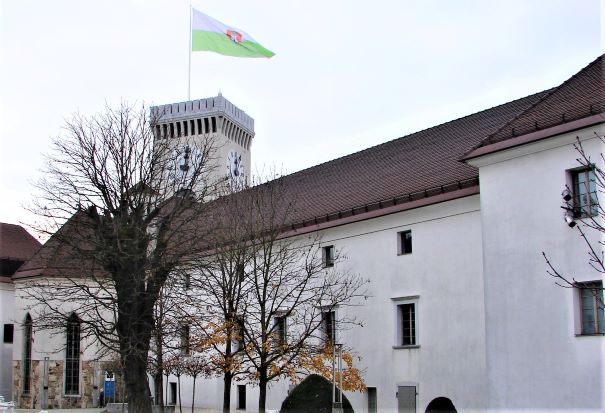
You’ve heard of the “House that Jack Built.” Ljubljana Castle is the “Castle that Jack Built.” Incongruous designs with mismatched architecture is the only way to describe it. That’s because a good part of the castle was built in the 15th century, with other portions constructed in the 16th and 17th centuries. The, the castle was left to waste away until the Communist period when some ugly structures were built. Part Swiss Chalet, part medieval tower, part gulag (the castle was a prison for a time), that’s the Ljubljana Castle.
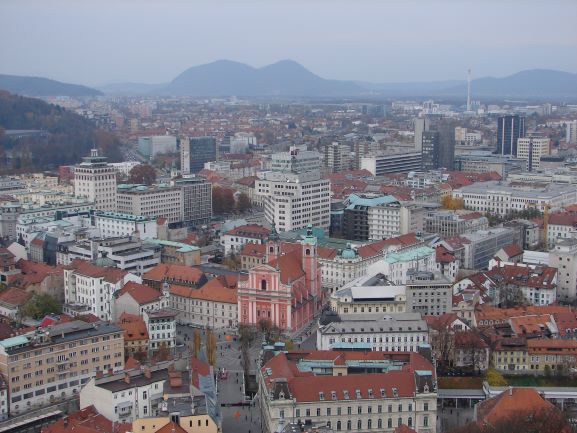
There are a couple of excellent restaurants in the castle including Gostilna Na gradu, which isn’t as expensive as you’d think, considering you’re dining in a castle!
Kremšnita
After all that sightseeing, you’re probably ready for something sweet. In Slovenia that means kremšnita, a custard cake with pastry dough, came to Slovenia via Serbia in 1953. At Hotel Park in Bled, Slovenia, over ten million kremÅ¡nita have been sold. But, the cake is also incredibly popular in Ljubljana. You can get a hunk of this creamy cake in practically any bakery in the city.
Slovenian Wine
And what goes better with a slice of kremšnita than a glass of white wine?
Slovenia is not internationally known as a wine producing powerhouse and that’s a shame because excellent wines are made here. Some of the varietals you’ll recognize, like Chardonnay, Cabernet Sauvignon, and Merlot. Others, like Teran or Refosco might be unfamiliar.
One of the most respected wineries in Slovenia is Movia, in the Brda Hills region of western Slovenia near the Italian border. Here, Aleš Kristančič (now closed) makes acclaimed wines. And best of all, Movia has a wine bar and shop located right in the Ljubljana City Hall Building.
St. Martin’s Day
November 11th is St. Martin’s Day, a feast day throughout Europe. This day is celebrated in different ways across the continent, but in Slovenia, it is the day when the new wine is unveiled.
We were walking home late on November 10th when we ducked into a small café for a hot chocolate and a piece of kremÅ¡nita. Inside, the bar was decorated with huge antique armoires, dressers, and hutches, draped with lace and stacked with mismatched antique plates.
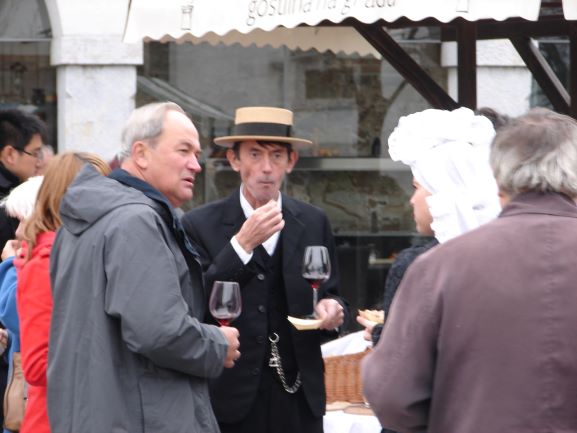
A few locals were sitting at the bar and tables. The young lady tending bar took our order and when she returned I asked her about all the signs I had seen for “St. Martin’s Day.”
She explained that tomorrow, Nov. 11th, was the day when the must was christened and could officially be drunk as wine. She also mentioned that their wine was sitting in the basement, waiting for tomorrow’s official celebration.
It was late, so I cheekily commented that it’s almost “tomorrow.” She must’ve liked my observation because she went to the basement and brought up a couple bottles of the unofficial “wine.” Pouring a glass for each of the patrons, she reminded us not to say anything to anyone about our crime against viticulture.
Metelcova
When the Yugoslav Army lost the war and Slovenia became independent, the army barracks at Metecova was abandoned. Squatters and artists soon established a residence here which the local government unsuccessfully tried to tear down. Today, the Metelkova City Autonomous Cultural Center has been designated as a cultural heritage location, which should preserve it.
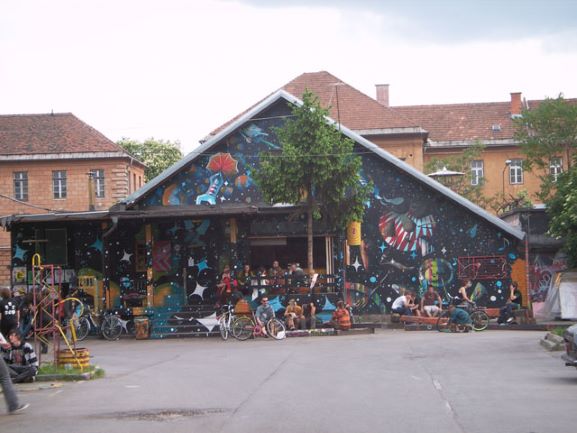
Alternative art installations and weed sales dominate the self-described independent city. And, at night, ad-hoc outdoor clubs selling illegal booze spring up.
Some residents frown on the taking of pictures, while others allow it; you should ask permission before taking anyone’s photo. Also, with the lack of police presence, there have been some reports of harder drugs making their way into Metelcova, and some tourists have said they have felt uneasy or even threatened. Judge for yourself, but act respectfully as you would in anyone’s home.
Day Trip to Lake Bled
Less than an hour from Ljubljana is picturesque Lake Bled. The town of Bled and its namesake lake are well-known to Slovenians, and now with international travelers as well. Hiking, rock climbing and watersports are very popular here.
The Church of the Assumption is on a tiny island in the middle of Lake Bled. The baroque church dates from the 17th century when it replaced a Gothic church damaged in an earthquake. Getting to the island is a fun mini-adventure. You can have someone take you there on a traditional Plenta boat for €12 roundtrip (they’ll wait and give you a half hour in the church). Or, you can rent a rowboat at the Castle Boathouse for €15-€20 an hour and get there under your own power.
Once on the island you’ll need to climb the 99 steps to get to the church. Legend has it that if a groom carries his wife up the steps, theirs will be a happy marriage. Needless to say, this idyllic setting is very popular for wedding ceremonies. There is a €6 admission charge to the church, which has some nice frescoes inside, but the real attraction is the wishing bell, which is just what it sounds like; ring the bell and make a wish. If you aren’t exhausted from the climb to the church, you can take the 92 step ascent up the bell tower for a fabulous view and picture opportunity with your camera or GoPro. If all this sounds a little touristy, it is. But, getting there on the boat, climbing the steps, ringing the bell, and admiring the scenery of Lake Bled does make for a lovely afternoon.
If you’re looking for something more remote, head to Triglav National Park. Forests, waterfalls, lakes, and mountains are waiting to be explored. Trails are well marked and there are rustic huts where you can stay overnight for a small fee.
Transportation
Ljubljana Jože Pučnik Airport
Direct flights from many European cities as well as Moscow and Istanbul. Seasonal service to Tel-Aviv.
Zgornji Brnik 130a, 4210 Brnik, Slovenia
Ground Transport
There are several options to get from the airport to Ljubljana (about 16 miles). There is currently no Uber in Slovenia.
Bus
Slovenia’s bus service (Arriva) has a stop right in front of the terminal. Buses leave every hour (less frequently on weekends. Easy and inexpensive.
Taxi
Taxis are plentiful outside the airport terminal. More expensive than the bus, but more convenient.
Shuttle
Private shuttles are available, but most require booking in advance and are expensive.
Rental Car
Ljubljana is compact and walkable, so a car isn’t needed. But, if you’re going to Lake Bled or the Julian Alps, a car might be a wise decision. Lots of companies at the airport rent cars to tourists.
Ljubljana railway station
Hub for trains to Croatia, Italy, Austria and beyond.
Trg Osvobodilne fronte 7, 1000 Ljubljana, Slovenia
Local transportation
Uber regulations are being discussed by the government, but the service is currently not available in Slovenia. Taxis are widely available.
Bus Service
There is a citywide public bus system in Ljubljana operated by LPP. Single trip tickets are cheap, but if you’re going to be riding the bus a lot, get the Urbana card and top it off for cheaper rides. Purchase the Urbana card at the green Urbanomat machines near most bus stops for €2 and fill it with up to €50. Or, if you’re visiting a lot of attractions in the city, get a Ljubljana Card and ride for free.
Kavalir
A unique and fun way to get around the city is in a Kavalir (Gallant Helper). Four small electric vehicles roam the city at a top speed of 25 kph. You can hail one for a free ride or call +386 (0)31 666 331 to have a Kavalir pick you up. Coverage area is limited to the city center and the service is provided by LPP, the local bus service.
Bikes
Bikes are a popular method of transportation since Ljubljana is a compact city. BicikeLJ is the local bike service with stations around the city. Ljubljana Bike also has a bike service from April through October.
Boats
Boats also run up and down the river, offering rides for about 8-10€. Several companies offer short tours.
Rental Car
A rental car might be a good idea if you’re going to Lake Bled or some other rural area.
Index of Things to Do in Ljubljana
Jože Pučnik House
Ljubljana’s favorite son. He designed many buildings in the capital including National and University Library as well as the Triple Bridge and Central Market.
Karunova ulica 6, Ljubljana 1000, Slovenia
LjubljanaYum
Food tours and cooking classes.
Makalonca
Great spot for drinks. Right on the river.
Hribarjevo nabrežje 19, Ljubljana
Cyanometer
Monolith in the city center that measures the blueness of the sky. Simultaneously artistic and scientific.
Metelcova
Artists’ commune and squatters’ residence in an old army barracks compound.
Church of the Assumption
Charming island church accessible only by boat.
Castle boathouse
Rowboat rentals to get to Bled Island.
Triglav National Park
Index of Food & Drink in Ljubljana
Zbornica
Wallet-friendly spot famous for their burgers but also have traditional Slovenian food with jota and ricet often on the menu.
Klobasarna
Traditional Slovene sausages and jota and ricet served in a fast casual atmosphere.
Ciril-Metodov trg 15, Ljubljana
Green One
Vegan restaurant serving veg. versions of traditional Slovene dishes.
Mestni trg 19, 1000 Ljubljana, Slovenia
Gostilna Na gradu
Restaurant located inside Ljubljana Castle. Surprisingly affordable considering the incredible location.
Grajska planota 1 | Ljubljana Castle, Ljubljana
Monstera Bistro
Nice lunch menu with organic wine list. Vegetarian options.
Å pajza
Multiple small dining rooms in a quaint house. Truffles available when in season.
Moji struklji
Struklji are available all over Ljubljana. This place makes some of the best.
Pokrita tržnica – južni del, Italijanska ulica 7, 1000 Ljubljana, Slovenia
Park Café in Bled, Slovenia
This is where the kremsnita cake originated. Lake Bled is beautiful and worth a trip, but if you’re just going for the cake, I’d suggest staying in Ljubljana. You’ll find lots of bakeries that make an excellent kremsnita.
Cesta svobode 10, Bled 4260, Slovenia
Index of Shopping in Ljubljana
Central Market
The place to get everything from fresh produce to meat to seafood to the famous local honey.
Vodnikov trg, Ljubljana 1000, Slovenia
Movia Winery
One of the most famous wineries in Slovenia with a bar and wine market inside the City Hall building.
Mestni trg 2, 1000 Ljubljana, Slovenia
Spin Vinyl
Great place to dig for vinyl and CDs, especially early Yugoslav punk titles.
Gallusovo nabrežje 13, Ljubljana, Slovenia
Krasevka
Shop with lots of local products.
Vodnikov Trg 4, Ljubljana, Slovenia
Carniola Antiqua
Best antique shop in Slovenia with a helpful staff.
Trubarjeva ulica 9, Ljubljana, Slovenia
Index of Places to Stay in Ljubljana
There are lots of big hotels that cater to business people in the new part of town. They are clean and usually include breakfast, if a bit sterile. For a more charming experience stay at a smaller place in the historic center.
Lesar Hotel
Boutique Hotel in the historic center of town. Nice outdoor garden.
Hotel Cubo
Excellent full service hotel in the historic center.
Slovenska cesta 15 | Slovenska Cesta 15, Ljubljana
Triglav National Park huts
Bare bones accommodation in Triglav National Park.
About the Author

Brent Petersen is the Editor-in-Chief of Destination Eat Drink. He currently resides in Setubal, Portugal. Brent has written the novel “Truffle Hunt” (Eckhartz Press) and the short story collection “That Bird.” He’s also written dozens of foodie travel guides to cities around the world on Destination Eat Drink, including in-depth eating and drinking guides to including the Hill Towns of Istria and Rovinj, Croatia. Brent’s podcast, also called Destination Eat Drink, is available on all major podcasting platforms and is distributed by the Radio Misfits Podcast Network.
